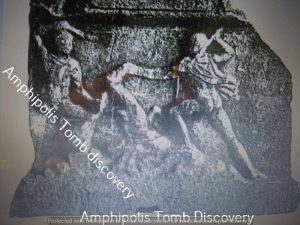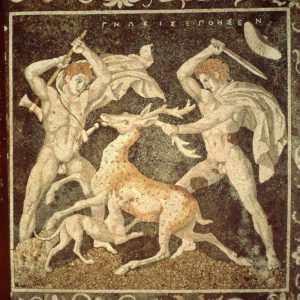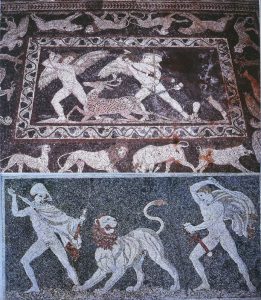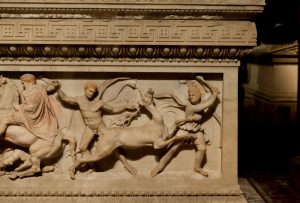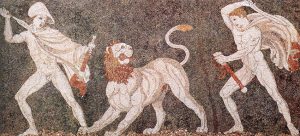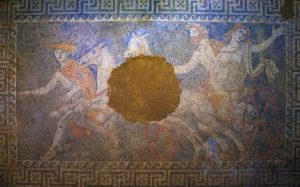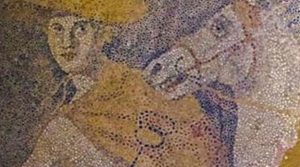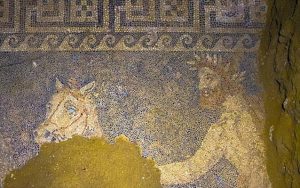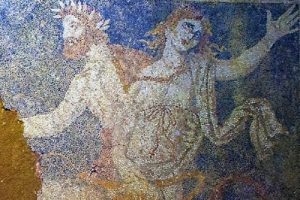A post by Vagelis Vagianos and a tribute to the archaeologist D. Diamantourou
An unknown relief is the beginning of an intellectual journey that will lead to a suspicion that we all have about the famous Amphipolis tomb mosaic that represents the abduction of Persephone.(photo 7)
But let’s present things from the beginning. The unknown relief was found in 1908 in Spata, Attica. It has dimensions of 0.68 x 0.50 x 0.12 and is made of white marble and remains unknown even to the academic public! The relief depicts two young men trying to kill a deer lying between them. The youngsters seem to be traversing uneven ground, which obviously indicates a mountainous landscape, far from its location, the Spata is located in a vast flat area. (photo 1)
So we have to deal with a hunting scene. But the amazing thing is that the animal, the young men’s body posture, the way their arms are held and their shapes, that they are naked wearing chlamyds refer to a miraculous precision to another artifact found far from the bas-relief. It is one of the world’s most famous mosaics of Pella, the capital of ancient Macedonia and the birthplace of Alexander the Great. (photo 2)
But a similar hunting scene was encountered in Macedonia and in the Hellenistic world. However, not often.
A comparable mosaic with the lion hunting in Pella was found in Alexandria, a lower art but with exactly the same attitude of the persons, in which the youngsters were replaced by winged Eros. (photo 3)
As also in the famous Alexander the Great sarcophagus at the Museum of Istanbul, in a corner of its decoration we see a similar hunting scene. (photo 4)
So is this scene related to Alexander? There have also been opinions by scholars that the scene of Pella’s mosaic of the lion hunting that pointing to Alexander for the right figure while the other young man is his close friend Krateros or Hephaestion. Something in which I will come back at the end.(photo 5)
Deer hunting is an artistic theme that is rarely encountered in the ancient world as opposed to lion hunting. Its appearance in the unknown bas-relief in the area of Spata, Attic, and its similar style with his mosaic of Pella may be related to the influence that the Macedonian kingdom still had in Athens, and the figures of the bas-relief are clearly Hellenistic. 4th century BC (dating from Prof. Kaltsas in his recording the “National Archaeological Museum”)
G. Rodenweldt was the first to publish the relief in 1923 and considers Spata’s relief to refer to the myth of Peleus and Eurytion while Erica Simpson proposes the myth of Ephialtis and Otus, the two Aleades who were killed eachother. This interpretation she used in a performance of a deer hunting on a vase from a private collection at the Basel Archaeological Museum, Switzerland. (photo 6)
It is evident that when we encountered with the same artistic theme presented by the same forms in different genres of art and in different regions, the perception that a myth is presented is the most logical explanation based on the tradition of ancient artists. After all, the deer hunting scene in Pella was found in a villa whose other mosaics referred to myths (Helen’s Abduction, Amazons)
But it seems to me quite plausible that artists who imitated their own myth in their works to represent in their portraits those who dominated at the time of their creation. So if Pella’s lion hunting could have represented Alexander and his friend Crateros or Hephaestion, we would have been able to guess the same for the Amphipolis’ tomb mosaic. The well-known myth of Persephone’s abduction that we also encountered in the royal tombs of Vergina, could have intervention of the artist in the faces that appear in the work.. Today, 2300 years after his creation, we all recognize artistic elements that could identify the leading Hermes – Alexander, the charioteer – Philip II and the redhead Persephone – Olympiad having the same face features with Hermes – Alexander (photo 7, 8 ,9 , 10)
The excavation team has avoided any reference to nomenclature that could have been derived from the mosaic, but it has nevertheless left a lot of hints about the skeleton of a short man found in the cist grave and aged 30-38; to be the main dead man. I am sure that the choice of the abduction of Persephone theme and the choice of the ancient artist to give the undoubted resemblance to the members of the royal Macedonian family will be the dominant point of discussion for the academic community in the upcoming years following the official publication and the evaluation of the findings (of those we know and those we don’t yet know).
Ps : Information on the unknown relief of Spata was derived from contemporary research by the memorable archaeologist Despina Diamantourou, the most of her work was dedicated to Pella.
